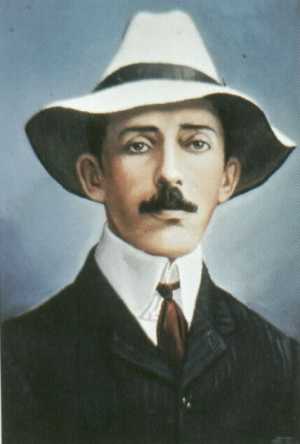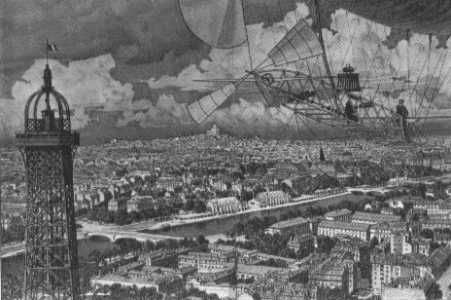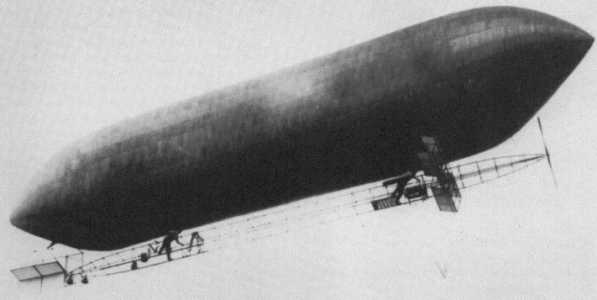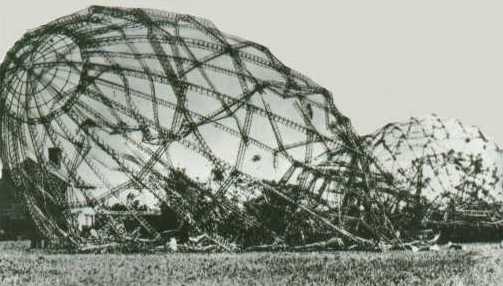|
the Dirigibles
keep coming
Once balloons were
outfitted with propulsion devices and
thus became dirigibles (or airships),
un-powered balloons were
used primarily for upper atmosphere research. In
July 1901, two ambitious
German physicists, Berson and
Surring, established an impressive altitude record of
thirty-five thousand feet (10,668km) that was to
stand for some thirty years.
In the early decade of the
twentieth century, airships
developed along three lines: those that consisted of a
balloon from which the power plant
and the crew quarters dangled were
known as non-rigid; airships with
a skeletal structure
encasing a balloon and to which a crew compartment and
propulsion system were attached
were called semi-rigid;
and airships that were made of a solid
outer shell, with the
passenger and crew compartments
attached and which had balloons inflated inside, were
known as rigid.


Alberto Santos-Dumont in his signature
floppy hat. The Brazilian aeronaut created a sensation
with
his 1901 flight around the Eiffel Tower, depicted in an
imaginary aerial view by Eugene Grasset.
Prior
to 1904, when he turned his attention to airplanes, the
pre-eminent builder of non-rigid airships was Alberto
Santos-Dumont. His flights over Paris delighted the
citizenry, particularly when a malfunction would result in a
crash, from which the diminutive Brazilian was lucky to
survive. He created a sensation in Paris (and entered
aviation history) when he flew around the Eiffel Tower in
his No. 6 and claimed the Deutsch de la Meurthe Prize
established in 1900. Santos-Dumont used his No. 14 airship
to test his aircraft before his historic flight of 1906.
In the United States, the non-rigid airships being
constructed by Thomas Baldwin were all the rage. The first
aircraft purchased by the U.S. military was a Baldwin
dirigible known as the SC1 Equipped with a Curtiss
motorcycle engine, these machines were easy to transport.
They found great use during World War I when they were used
extensively by the British and French for offshore
antisubmarine patrol.

In the first decade of the twentieth century,
experimenters in flight investigated
both heavier- and lighter-than-air machines. Thomas Baldwin
and
Glenn Curtiss test a Baldwin dirigible at Fort Myer on
August 18, 1908.
Semi-rigid airships replaced non-rigid
ones with the improvement of motors and propellers, and a
streamlined design boosted speed. Several successful
semi-rigid airships were built by Paul and Pierre Lebaudy
before 1910, and they performed so well that several
governments ordered them for their fleets. A typical Lebaudy
airship might be two hundred feet (61m) long and thirty feet
(9m) in diameter, powered by engines of 70 to 100 horse-
power, carrying a crew of four, and capable of covering
distances of several hundred miles at a clip of
forty-five to fifty miles per hour.
In England, the
flamboyant American aerial showman Samuel E Cody teamed up
with aerialist Colonel J.E. Capper to build the Nulli
Secundus (“Second to None”), a semi-rigid airship
that amazed Londoners in flights on October 5, 1907, and
became a popular attraction when exhibited at the Crystal
Palace. (The airship was torn apart just five days into the
exhibit, however.)
The semi-rigid airships were abandoned
after 1911, but only because German rigid airships performed
so much better. In the United States, semi-rigid airships
did not fare so well: The America, a semi-rigid dirigible
built by Walter Wellman, made two failed attempts to reach
the North Pole and went down in the ocean during a 1906
attempt to cross the Atlantic. The crew was rescued, but one
of them, Melville Vaniman, decided to try again. His ship,
the Akron, caught fire and crashed off the coast of Atlantic
City, New Jersey, on July 2, 1912, killing Vaniman and his
crew of four.
The era of the rigid airships is easy to
pinpoint: it begins on July 2, 1900, with the flight of the Luftschiff Zeppelin 1 (LZ 1), over Lake Constance, Germany,
and it ends with the Hindenburg disaster on May 5, 1937.
Count Ferdinand Graf von Zeppelin had been an observer of
the use of military balloons during the American Civil War,
and soon became convinced that large dirigibles would be an
effective means of air transportation.
The LZ 1, designed by chief engineer
Ludwig Durr, was 420 feet (128m) long and thirty-eight feet
(11 .5m) in diameter, with sixteen internal cells for
lifting gas encased in a shell of aluminium and cotton.
The dirigibles built by Zeppelin’s company, DELAG, from LZ 1
to LZ 129 (the Hindenburg) varied in details, but they were
all modelled on the principles established by the first one.

remains of the L33 during WW1
In the years prior to World War I,
five DELAG Zeppelins (for by now the name had become
synonymous with the aircraft) carried some thirty-five
thousand passengers over long distances without mishap. The
only fatalities were incurred in late 1913 when the two
airships were on military missions. During World War I,
Germany built more than one hundred airships for the purpose
of bombing London, but these were no match even for the
primitive fighters the British sent up against them. It was
just as well, then, that the British rigid airship program
never got off the ground. Its one attempt, the Vickers May
fly, designed to be the largest then aloft (at 510 feet
[155.5mj long), was torn apart by a strong wind as it was
taken out of its hangar for a test flight.
|
